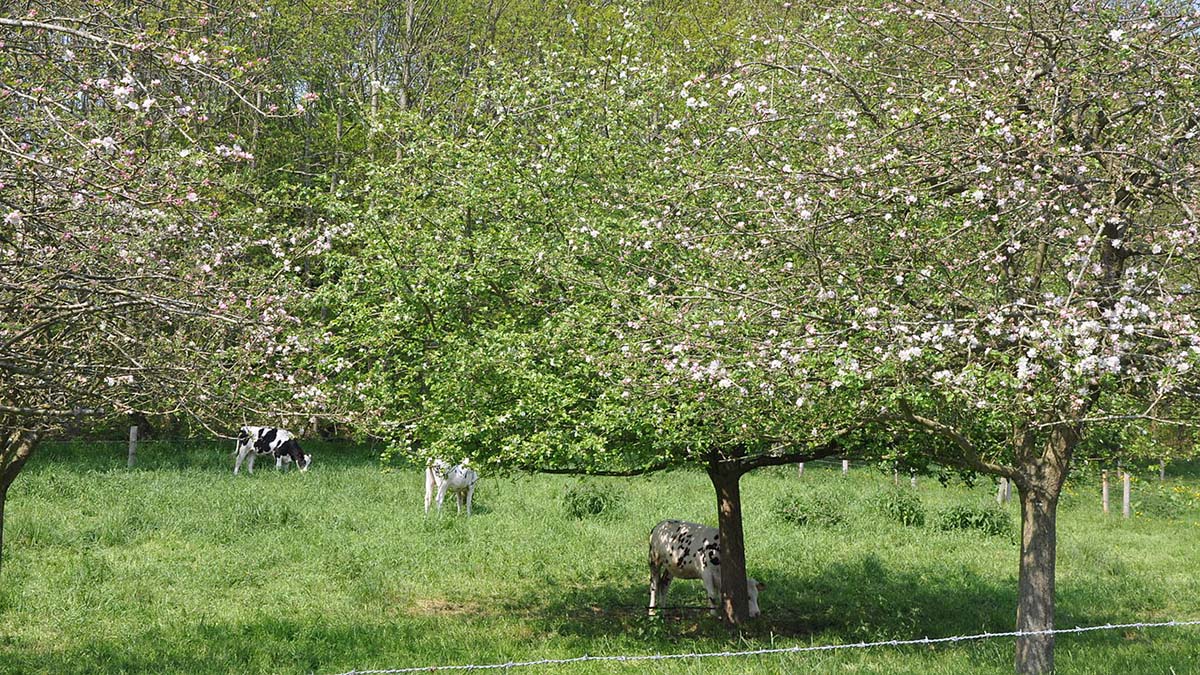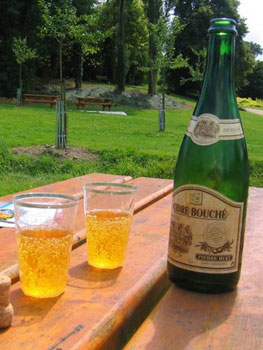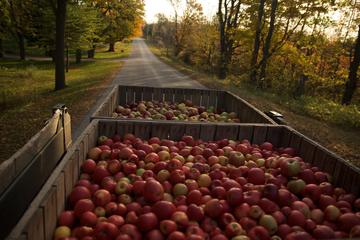
by Valeria Teo
“Normandy is proud of their apple trees,” my French friend told me. There was certainly ample truth in it as the Cider Route (La Route du Cidre) was proposed in 1973 to let people discover and appreciate the great quality of the wine in the region of Pays d’Auge.
 We headed for this scenic route, officially inaugurated on 25 May 1975, on a sunny day in July. It took us less than one hour, by taking the N13 from Caen, to reach the starting point of the Cider Route, Cambremer.
We headed for this scenic route, officially inaugurated on 25 May 1975, on a sunny day in July. It took us less than one hour, by taking the N13 from Caen, to reach the starting point of the Cider Route, Cambremer.
The Cider Route might be considered as a tourist attraction with all the brochures in the small Cambremer Tourist Information Office. But the inhabitants seemed to have other ideas about it. The village followed her own leisure tempo and invited people to laze around. There were no crowds of tourists; in fact there was not a single soul on the street when we arrived in the summer heat. Time appeared at a standstill in such countryside serenity.
When we studied the materials, we immediately understood where the Normandy pride came from:
To the East of Caen, the Cider Route is at the heart of the geographical zone known as the Appellation d’Origine Contrôleé (AOC) des Cidres du Pays d’Auge. AOC is linked to a given region in France. Its soil, sub-soil, climate, environment and varieties of apples determine and ensure the quality and standards of the products with this label. There are three principal checks for obtaining the AOC label: a declaration system with visits of the business, a chemical analysis of the beverage carried out by an approved laboratory and a taste examination. There are seven AOC labels for the drinks made from the Normandy apples, namely Calvados (AOC), Calvados du Pays d’Auge (AOC), Calvados Domfrontais (AOC), Pommeau de Normandie (AOC), Pommeau du Maine (AOC), Cidre du Pays d’Auge (AOC) and Cidre du Pays d’Auge Cambremer (AOC).
 Cider-makers on the Cider Route compete annually and those selected display the sign “Cru de Cambremer” on the roadside at the entrances to their farms. Nineteen producers have been awarded the “Cru de Cambremer” in 2010 and nine of them offer guided tours. The specified products of these “Cru de Cambremer” can be marketed under the label Cidre du Pays d’Auge (AOC), Cidre du Pays d’Auge Cambremer (AOC) or Calvados du Pays d’Auge (AOC).
Cider-makers on the Cider Route compete annually and those selected display the sign “Cru de Cambremer” on the roadside at the entrances to their farms. Nineteen producers have been awarded the “Cru de Cambremer” in 2010 and nine of them offer guided tours. The specified products of these “Cru de Cambremer” can be marketed under the label Cidre du Pays d’Auge (AOC), Cidre du Pays d’Auge Cambremer (AOC) or Calvados du Pays d’Auge (AOC).
We visited one of the “Cru de Cambremer” located right at the entrance of Cambremer. Before finding ourselves, with a nice surprise, in an English guided tour around the premises, we took the time to enjoy our first bottle of cider brewed there. It certainly added to our amusement to be surrounded by the rolling pastures and accompanied by the crowing cocks.
“The farm covers 100 hectares of land with 20 hectares of low-stemmed apple trees and 40 hectares of high-stemmed ones.” Our guide, a young lady, said in an accented voice as she showed our group of eight people around the farm. “Here we grow thirty different species of apples.” I wondered how we could tell the differences between all these apples. For us, they all looked similar.
We were looking at the seemingly boundless farmland while our guide went on with her talk. “The yield per hectare is limited to 30 tonnes for low-stemmed apple trees and 20 tonnes per hectare for high-stemmed ones. This ensures the quality of the apples. Many farms prefer the low-stemmed apple trees nowadays as they can be machine harvested which saves a lot of manpower.”
“Here we produce three types of alcoholic drinks from apple juice, namely cider, pommeau and calvados.” The group was standing by a grinding machine as the guide led us inside the premises. “About 750 liter of juice can be produced per tonne of apples after the harvest around September. With an average annual harvest of about 500 tonnes of apples, 320 tonnes are used for producing Calvados and the remaining 180 tonnes for pommeau, cider, apple juice and vinegar.”
We followed the guide towards a couple of giant tanks. “Cider is the first product from the juice after the process of natural fermentation without any addition of yeast. The liquid is kept in large tanks between six weeks and four months to produce an alcoholic content of 3.5 – 5%.”
The guide paused and made way to let the group see more of the fermentation tanks. Cider of different alcoholic content and taste was fermented for different periods of time. We found increasing alcoholic content and thus decreasing taste of sweetness in Cidre Demi-Sec (half-dry) and Cidre Brut (dry). As fermentation was a natural process, cider of lower alcoholic content kept at room temperature could be changed slowly into one with higher alcoholic content. So we could get a bottle of Cidre Brut after buying a bottle of Cidre Demi-Sec!
 Our next stop was the distillery for making calvados – an apple brandy produced from cider by double distillation. The liquid, which was just 10% in volume of the pre-distilled cider, was kept in large oak barrels between three and 30 years to give different brands of calvados.
Our next stop was the distillery for making calvados – an apple brandy produced from cider by double distillation. The liquid, which was just 10% in volume of the pre-distilled cider, was kept in large oak barrels between three and 30 years to give different brands of calvados.
We were amazed at the sheer size of the barrels as we entered the cool cell. The guide explained with a sense of pride. “The largest barrels in the vineyard are almost three meters in diameters. We’ve used them for more than 100 years, half way through their normal life span. Nowadays only the smaller barrels, half in size, are manufactured in Pays d’Auge.”
We occasionally saw the calvados-maker climb up the big barrels to add water for diluting the alcohol and keeping the barrels full as liquid was lost by evaporation. A strong aroma of alcohol with a tint of oak diffused the room. The calvados available for sale contains about 40% alcohol.
The group was slowly approaching the shop where the tour had started. Our guide closed with a brief introduction on pommeau. “Finally, there is the pommeau which is an aperitif in Normandy. It is a mixture of two-third of apple juice and one-third of calvados, making the final alcoholic content to about 17%. The mixture is kept in tanks for at least 14 months before sale. The taste is like sweet whisky and is pretty good.”
The visit was unavoidably ended with a round of delightful shopping. We paid just one third of the price in the vineyard for the same volume of cider we ordered in any Normandy restaurant. How could anyone resist the temptation?

Small-Group Half-Day Normandy Cheese and Cider Tour from Caen
If You Go:
Cambremer, located 35 km from Caen or 13 km from Lisieux, is between the road N13 and the highway A13. If you travel from Paris or Rouen, follow A13 until the exit at “la Haie Tondue” or ‘Dozulé”. The road signs are sufficiently clear to take you all the way to Cambremer. The list of “Cru de Cambremer” changes from year to year. It is a good idea to check the link before you visit. Calvados Tourism, Cambremer Tourist Information Office
About the author:
Valeria Teo is a writer and an independent traveler. Her trips have taken her to nearly 30 countries. Having published three travel romances and one collection of essays, she also writes for Suite 101, Mahalo.com, UTravel.com, magazines, newspapers and online publications in both English and Chinese. Born in Hong Kong, she now divides her time between her homes in Split, Croatia and Hong Kong.
Photo credits:
First Normandy orchard photo by: Philippe Alès / CC BY-SA
All other photos are by Valeria Teo.


